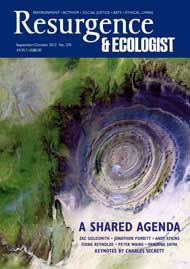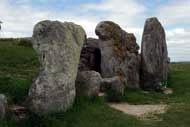It was a perfect midwinter’s morning, the sun shining on an overnight frost. I headed to the most striking feature in the ancient landscape of Avebury. The cone-like mound of Silbury Hill is Britain’s own pyramid. Constructed with chalk and clay in the late Neolithic age, it was once pure white. Its original purpose is now a mystery. Excavations have never uncovered the tombs expected there. The lack of hard evidence to explain exactly what it meant to those who built it adds to its allure.
Each step along its steep rise elevated my perspective from everyday concerns. I was aware of not being alone: the soft rural landscape harboured layers of human history and the varied beliefs of those who had come this way before me. For thousands of years, Silbury was part of a processional route for pilgrims to honour the Earth and her cycles. Our ancestors regarded the heights as a gateway to the wisdom of the ‘upper world’. Silbury Hill, rising so prominently from the fields around it, points to the constellations from which the ancients drew cosmic inspiration.
Even now, some 4,500 years since it was built, it’s possible to trace interlocking blocks of chalk, arranged as steps. Angled at 30 degrees, Silbury has withstood the test of time. This engineering knowledge, in common with the alignments threading through Wiltshire’s concentration of sacred sites, was no accident. Surviving relics around the world testify to a remarkable knowledge of mathematics, astronomy, geomagnetic forces and building techniques, outperforming in some cases anything we could reproduce now.
A few metres beyond a pronounced ledge, I reached a surprisingly large plateau at the top. The atmosphere felt a world away from the traffic, pylons and houses below. A dozen or so sheep must have felt the same. Most were lying down, unmoved by the sudden appearance of an intruder on their evidently well-used grazing area. A gentle peace flooded over me as I scanned the horizon of prehistory, from Avebury in the north-east, with the world’s largest stone circle, to the burial sites of West and East Kennet Long Barrows, and Stonehenge due south of Avebury, joined together by an ancient pathway. They are aligned not only to each other physically, but also to the sun, moon and stars, like living calendars of time’s passing.
The view from Silbury Hill bridged the very distant past with its continuing heritage. The footsteps of our ancestors are held within the land like imprints. Similarly, from where I stood none of the sites looked like protrusions; rather, they were features integrated into its undulating topography. Increasingly, seekers are being drawn to such places of ancient worship, to be informed by the original wisdom behind them. I too felt connected to the reverence of the ancestors, who understood the interconnectedness of all life.
The view and feeling of living history were pulling me like a magnet to the older, snake-like form of West Kennet Long Barrow about a mile away. Beyond the A4 Roman road splicing the landscape, I passed an impressive old oak tree with ribbons tied as prayer bundles to the branches. The Mary current of the Michael Line flows through the hill to the source of the River Kennett, Swallow Head Spring, and on to West Kennet Long Barrow. Constructed around 3,500 BCE, the 100-metre-long burial chamber would have dominated the skyline for local settlers long before Silbury’s time. It was closed down as a ritual site some 1,000 years later, as the great stone circle at Avebury was begun, and possibly also Stonehenge.
Trudging towards the Long Barrow felt surreal: it had always been at the centre of pastoral life. Now covered in grass, it would have been all the more striking from afar when it was pure chalk white. Until I reached the entrance, there was nothing sheltering me from a sudden breeze blowing from the east.
I stood before the vast sarsen stones that guarded West Kennet and had sealed it up. Intriguingly, the largest is vulva-like, with a gash up its centre. I leaned my back against it and closed my eyes. At once, a confluence of impressions and feelings rose within me like converging timelines. This hallowed ground had certainly aided certain rites of passage, necessary for the expanded awareness of those who came here. One has to step inside the barrow, journeying from daylight into the darkness of its five chambers, a passage from the known to the unknown.
Inside was pitch black. I tried to imagine the light of the Pleiades, Sirius and the moon still flooding some of the chambers on key dates. I shuffled along towards the biggest chamber at the end and sat still in the thick silence.
I lit a match and the stones started to animate, each with its own features. The shadows brought alive the apparently solid world of rock. The vast slabs had stood as sentinels for more than 5,000 years, guardians of the mysteries of the universe experienced in ceremonies and rituals held in this chamber. Two stones in the corners of the tomb’s end wall would have been used as portals to the spirit realms beyond. Time can only appear to move differently in such a dark space, disorientating the senses. I have no idea how long I stayed there. Eventually a feeling of stiffness and a damp bottom both suggested it was time to head outside.
In the fresh air, I felt aware of a continuing conversation between this site and its unexcavated partner. East Kennet Long Barrow is aligned to the midwinter sunrise, and West Kennet to the midwinter sunset. I hoped it would remain sealed up, its secrets forever unprobed. Celebrating mystery in an age where certainty is pursued opens up a world of possibility. Those hours spent immersed in the living wonder of two sites eclipsed in celebrity by Stonehenge and Avebury were enriching.
Silbury Hill is a mile west of West Kennet, just off the A4 in Wiltshire. Avebury is six miles west of Marlborough.
For more information: West Kennett Long Barrow: Landscape, Shamans and the Cosmos", Peter Knight. www.stoneseeker.net/







